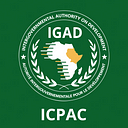Gender gaps in climate resilience and adaptation in the Eastern Africa region
Melisa Ouya with contributions from the IGAD Climate Change Technical Working Group.
Climate change affects people and the environment differently. While everyone is impacted by climate change, the effects are not equally distributed across gender lines. Despite climate change disproportionately affecting women, there are often significant gender gaps in adaptation and resilience efforts. In the last couple of years, Eastern Africa has gone through some of the most erratic weather patterns, causing it to be the most susceptible of all the regions.
The Sixth Assessment Report (AR6) of the Intergovernmental Panel on Climate Change (IPCC) indicates a rapid increase in human-induced global warming in Africa compared to other regions. Droughts, floods, and other extreme weather events are becoming more frequent and intense, which has severe implications for food security, water resources, and human health.
These changes affect women and men in the region differently, primarily due to pre-existing gender inequalities. Women, who are often responsible for agriculture, making up 43% of its labour force, according to the Food and Agriculture Organization and household water management, are more likely to suffer from food and water shortages when these resources become scarce.
In addition to a lack of decision-making power, women mostly lack adequate access to financing, farm resources, land ownership, and extension services.
They are also more likely to experience gender-based violence, including sexual assault and exploitation, in the context of climate-induced displacement.
The development of Climate-Smart Agriculture (CSA) and Regenerative Agriculture across the region has broadly been adopted to address resilience and adaptation to climate change due to the growing awareness of the environment and social impacts of conventional agriculture practices. Remarkable progress is acknowledged in building resilience and adaptation capacity for disaster preparedness, climate mitigation, diversification of economies and food systems, provision of social safety nets, education and training, and infrastructure investment.
However, gender differential impacts of climate change and gender inequalities continue to augment the gaps in resilience and adaptation processes.
Gender inequalities have been reported in access to technology, climate, and early warning information. The various communication channels make them dependent only on information from agricultural officers, who are not always accessible. Gender roles tend to render women as caregivers and not decision-makers, demining their bargaining and power capacity at the household levels.
Capacity-building opportunities offered within the communities as a resilience strategy tend to benefit only the educated, considering much of the population in the most vulnerable communities have low literacy levels.
Female representation in formal institutions is generally low, meaning men often dominate capacity building on climate resilience set aside for local government offices.
Social norms in many parts of the region also reinforce unsustainable practices by creating barriers to the collective action of both genders and perpetrating inequalities in climate resilience. Norms impact how men and women express and respond to climate change impacts and limit their ability to adapt and build resilience. They limit access to resources and opportunities necessary to adapt to climate change. The ability to participate in resilience and adaptation is deprived by how much time one must delegate their other roles.
The lack of gender-disaggregated data to support the arguments of climate inequalities in the region creates limitations in quantifying the inequalities. It undermines efforts to design gender-responsive interventions to enable women to cope with and adapt to climate change impacts. Therefore, gender-disaggregated data is needed to help understand vulnerability and capacity, particularly in the documentation of climate impacts. It is also essential in designing evidence-based programmes and interventions.
Despite the gaps, several deliberate measures have been taken in a quest to reduce gender inequality gaps, including political representation across the region. According to the Organisation for Economic Co-operation and Development (OECD), there has been an increase in women’s political leadership and participation in decision-making. Many African countries endorsed legislative reforms addressing gender-based violence and reducing inequalities in access to land and financial resources between 2014 and 2020. Similarly, Inter-Parliamentary Union (IPU) data shows that women made up 25.5% of the national parliamentarians worldwide in 2021, while the average rate of women in African national parliaments is a little higher, at about 25.9%.
On the other hand, women are still underrepresented in the corporate sector and leadership roles. According to the African Development Bank’s African Gender Equality Index, only 12% of African corporations’ board directors were women in 2019.
To address these gender gaps in climate change adaptation and resilience, there is a need for more robust governance structures and more gender-sensitive policies while ensuring planning for implementing strategies and actions, considering the different needs and experiences. Gendered budgeting is critical in policymaking for representation and in the planning and implementation of such policies to address inequalities. Mainstreaming gender to climate resilience and adaptation and resilience-building initiatives should also be considered.
Additionally, investment in women’s education, training, and capacity building to equip people with knowledge, skills, and resources to make informed decisions and take action to address challenges should be increased. Also, access to tailored and understandable climate information, including visualization and local languages, should be strengthened. Lastly, gender-disaggregated data and in-depth research should be undertaken to understand better how social, political, and cultural structures intersect to create and sustain gender-differentiated impacts on climate change.
